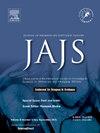接受双侧同时全膝关节置换术患者的组件尺寸与膝关节功能评分之间的相关性:横断面研究
Q4 Medicine
引用次数: 0
摘要
同时双侧全膝关节置换术(simultaneous bilateral total knee arthropasty,simBTKA)一直是减少费用和患者痛苦的首选手术方案。我们认为植入物不对称可能会影响患者的功能预后,因此我们旨在评估接受 simBTKA 的患者膝关节组件大小不对称的比例及其对膝关节功能的影响。 我们采用横断面研究设计,使用患者特异性模板(PST)对 60 名患者(120 个膝关节)进行了 simBTKA。如果患者患有凯尔格伦-劳伦斯 III-IV 级骨关节炎,则将其纳入研究范围。翻修手术、分期 BTKA 或有骨缺损、外翻畸形、严重外翻畸形(定义为超过 20°)和关节外畸形的患者不在研究范围内。结果测量指标包括肢体间的不对称、膝关节社会评分(KSS)和活动范围(ROM)。术前和术后结果的比较采用依赖性 t 检验。 共有29名(48.34%)患者的股骨和胫骨组件对称,而其余患者的股骨和胫骨组件不对称,其中11.7%的患者股骨和胫骨组件大小均不对称。小植入体组和大植入体组的KSS和ROM变化差异无统计学意义(分别为P = 0.5和P = 0.4)。并发症总数为8例,具体如下:表皮感染、无菌性松动、浴室摔倒后髌腱断裂、贫血需要输血、残余屈曲畸形、深静脉血栓、假体周围骨折和错位。 肢体间组件不对称与膝关节功能之间没有相关性。不过,从统计学角度来看,小植入物和大植入物的 KSS 和 ROM 从术前到术后都有明显改善。本文章由计算机程序翻译,如有差异,请以英文原文为准。
Correlation between Component Size and Functional Knee Score in Patients Undergoing Bilateral Simultaneous Total Knee Arthroplasty: A Cross-Sectional Study
Simultaneous bilateral total knee arthroplasty (simBTKA) has been a favored surgical solution to reduce costs and patient suffering. We aimed to evaluate the rate of asymmetry of component size in patients undergoing simBTKA and its impact on knee function as we believe that implant asymmetry may affect the functional outcomes in those patients.
A cross-sectional study design was done on on 60 patients (120 knees) with simBTKA using patient-specific templating (PST). Patients were included if they had Kellgren–Lawrence Grade III-IV osteoarthritis. Revision surgeries, staged BTKA, or patients with bone defects, valgus deformity, severe varus deformity (defined as above 20°), and extra-articular deformities were excluded from the study. The outcome measures were interlimb component asymmetry, Knee Society Score (KSS), and range of motion (ROM). The comparison between pre- and postoperative findings was done using a dependent t-test.
A total of 29 (48.34%) patients had symmetrical femoral and tibial components, whereas the rest had asymmetry, of them, 11.7% had both femoral and tibial component size asymmetry. There were no statistically significant differences between the changes in KSS and ROM in the smaller implant and larger implant groups (P = 0.5 and P = 0.4, respectively). The total number of complications was eight and as follows: superficial infection, aseptic loosening, rupture of the patellar tendon after a bathroom fall, anemia requiring blood transfusion, residual varus deformity, deep venous thrombosis, periprosthetic fracture, and malalignment.
There is no correlation between the interlimb component asymmetry and the knee function. However, there was statistically significant improvement from preoperative to postoperative KSS and ROM in small and large implants.
求助全文
通过发布文献求助,成功后即可免费获取论文全文。
去求助
来源期刊

Journal of Arthroscopy and Joint Surgery
Medicine-Orthopedics and Sports Medicine
CiteScore
0.60
自引率
0.00%
发文量
1
期刊介绍:
Journal of Arthroscopy and Joint Surgery (JAJS) is committed to bring forth scientific manuscripts in the form of original research articles, current concept reviews, meta-analyses, case reports and letters to the editor. The focus of the Journal is to present wide-ranging, multi-disciplinary perspectives on the problems of the joints that are amenable with Arthroscopy and Arthroplasty. Though Arthroscopy and Arthroplasty entail surgical procedures, the Journal shall not restrict itself to these purely surgical procedures and will also encompass pharmacological, rehabilitative and physical measures that can prevent or postpone the execution of a surgical procedure. The Journal will also publish scientific research related to tissues other than joints that would ultimately have an effect on the joint function.
 求助内容:
求助内容: 应助结果提醒方式:
应助结果提醒方式:


